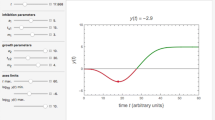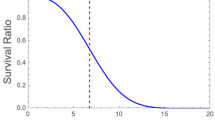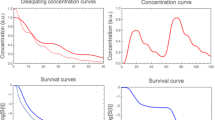Abstract
The response of microorganisms to chemical preservatives and disinfectants can be described by the traditional Chick-Watson-Hom’s (CWH) model or more general Weibullian survival model, of which it is a special case. The chemical agent efficacy and its concentration dependence can be described by either a power-law or log-exponential term. For dynamic inactivation, the unstable or volatile agent’s dissipation can be described by a flexible two-parameter model, which is inserted as an algebraic term into the differential rate equation. In principle, both models can be used to estimate a targeted microbe’s survival parameters from the agent’s concentrations when constant or its initial and final concentrations only if not, and the corresponding final survival ratios reached. This Endpoints Method eliminates the need to determine the entire survival curves, and in the dynamic case the agent’s entire dissipation curves too. Static inactivation requires the numerical solution of simultaneous nonlinear algebraic equations, and dynamic, of simultaneous nonlinear equations whose right-hand side is the numerical solution of differential rate equations in which the agent’s dissipating pattern is incorporated as a term. When the Weibullian survival model’s shape factor is known a priori, the theoretical minimum of experimental final survival ratios needed is two and when unknown three. However, validation of the model and mathematical procedure must come from their ability to predict correctly final survival ratios not used in the parameter magnitudes calculation, which requires at least one additional experimental final survival ratio determination.








Similar content being viewed by others
References
Springthorpe S, Sander M, Nolan K, Sattar SA (2001) Comparison of static and dynamic disinfection models for bacteria and viruses in water of varying quality. Water Sci Technol 43:247–154
Peleg M (2020) Endpoints Method for predicting microbial inactivation, nutrients degradation and quality loss at high and ultra high temperatures. Food Safety Eng. A. Demirci, H. Feng, and K. Krishnamurthy. (Editors). Springer. pp. 421–446
Corradini MG, Normand MD, Newcomer C, Schaffner DW, Peleg M (2009) Extracting survival parameters from isothermal, isobaric and ‘iso-concentration’ inactivation experiments by the ‘three end points method.’ J Food Sci 74:R1–R11
Gyurek LL, Finch GR (1998) Modeling water treatment chemical disinfection kinetics. J Environ Eng 14:783–793
Rossi R, Antonelli M, Mezzanotte V, Nurizzo C (2007) Peracetic acid disinfection: a feasible alternative to wastewater chlorination. Water Environ Res 79:341–350
Chick H (1908) Investigation of the laws of disinfection. Epidiomiol Infect 8:92-158
Haas CN, Joffe J (1994) Disinfection under dynamic conditions: modification of Hom’s model for decay. Environ Sci Technol 28:1367–1469
John DE, Haas CN, Nwachuku N, Gebra CP (2005) Chlorine and ozone disinfection of Encephalitozoon intestinalis spores. Water Res 39:2369–2375
Mounaouer B, Abdennaceur H (2016) Modeling and kinetic characterization of wastewater disinfection using chlorine and UV irradiation. Environ Sci Pollut Res 23:19861–19875
Santoro DR. Gehr TA, Bartrand L., Liberti M, Notarnicola A, Dell’Erba D, Falsanisi, Haas CN (2007) Wastewater disinfection by peracetic acid: Assessment of models for tracking residual measurements and inactivation. Water Environ Res 79:775-787
Van Boekel MAJS (2002) On the use of the Weibull model to describe thermal inactivation of microbial vegetative cells. Intnl J Food Microbiol 74:139–159
Corradini MG, Peleg M (2003) A model of microbial survival curves in water treated with a volatile agent. J Appl Microbiol 95:1268–1276
Peleg M (2021a) Microbial dose-response curves and disinfection efficacy models revisited. Food Engng Rev 13:305–321
Peleg M (2021b) Modeling the dynamic kinetics of microbial disinfection with dissipating chemical agents—a theoretical investigation. Appl Microbiol Biotechnol 105:539–549
Peleg M, Penchina C (2000) Modeling microbial survival during exposure to a lethal agent with varying intensity. Crit Rev Food Sci Nutr 40:159–172
Peleg M (2006) Advanced quantitative microbiology for foods and biosystems. Taylor & Francis, Boca Raton Fl
Peleg M, Normand MD, Corradini MG, van Asselt AJ, de Jong P, ter Steeg PF (2008) Estimating the heat resistance parameters of bacterial spores from their survival ratios at the end of UHT and other heat treatments. Crit Rev Food Sci Nutr 48:634–648
Clark RM (1998). Chlorine demand and TTHM formation kinetics: A second-order model. J Environ Eng 124:16-24
Ragazzo PN, Chiucchini, Picolo V, Sapodini M, Carrer S, Zanon F, Gehr R (2020) Wastewater disinfection: long-term laboratory and full-scale studies on performic acid in comparison with peracetic acid and chlorine. Water Res 184: 116169
Sahulka SQ, Bhattarai B, Bhattaxharajee A, Tanne W, Mahar RB, Goel R (2021) Differences in chlorine and paracetic acid disinfection kinetics of Enterococcus faecalis and Escherichia fergusoni and their susceptible strains based on gene expressions and genomics. Water Res 203: 117480
Acknowledgements
The author expresses his deep gratitude to Mark D. Normand who wrote the original programs to retrieve kinetic parameters from residual survival ratios in static and dynamic thermal and non-thermal microbial inactivation.
Author information
Authors and Affiliations
Corresponding author
Ethics declarations
Conflict of Interest
The author declares no competing interests.
Additional information
Publisher's Note
Springer Nature remains neutral with regard to jurisdictional claims in published maps and institutional affiliations.
Rights and permissions
About this article
Cite this article
Peleg, M. Retrieval of Microbial Inactivation Kinetic Parameters in Chemical Preservation and Disinfection by the Endpoints Method. Food Eng Rev 14, 617–628 (2022). https://doi.org/10.1007/s12393-022-09310-6
Received:
Accepted:
Published:
Issue Date:
DOI: https://doi.org/10.1007/s12393-022-09310-6




